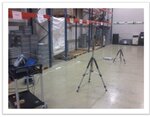Julew
Member level 1
Hello,
I am measuring a 2.4Ghz Zigbee device´s radiation pattern. I haven´t got an anechoic chamber so i am measuring it in "free space" using a tripod. One side i have the device transmiting at 0dBm in a rotary head. In the other side i have a 5 segment Yagi antenna (cheap, high gain and polarized) connected to a spectrum analyzer. I would like your opinion about tripod position. They are 1.2 meter from graound and 3 meters away as you can see in the picture.


I know that i am going to have reflections. I think walls are not going to affect to much the measurement. I am receiving -50dBm signal so wall signals must be -100dBm. I have been moving the setup and the measured pattern is more or less equal. Maybe the ground has more effect in the measurement but i don´t know how to avoid it. How would you improve the measurement setup?
Thanks a lot!
I am measuring a 2.4Ghz Zigbee device´s radiation pattern. I haven´t got an anechoic chamber so i am measuring it in "free space" using a tripod. One side i have the device transmiting at 0dBm in a rotary head. In the other side i have a 5 segment Yagi antenna (cheap, high gain and polarized) connected to a spectrum analyzer. I would like your opinion about tripod position. They are 1.2 meter from graound and 3 meters away as you can see in the picture.


I know that i am going to have reflections. I think walls are not going to affect to much the measurement. I am receiving -50dBm signal so wall signals must be -100dBm. I have been moving the setup and the measured pattern is more or less equal. Maybe the ground has more effect in the measurement but i don´t know how to avoid it. How would you improve the measurement setup?
Thanks a lot!